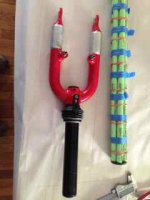liveforphysics
100 TW
I mixed equal amounts of this grease:
http://www.americansealantsinc.com/wp-content/files_mf/asi70pds.pdf
With this rolled graphene carbon nanotube material from OCSiAl in approximately equal masses.
https://www.youtube.com/watch?v=hy_5k099tYc
I'm excited to measure it's effects on conductivity of clamped electrical connections. I will share my results with the forum, I'm just doing the tests as a fun project on my own time. My hope is that it may enable easy DIY pack designs like Snath's clever foam pressure on dimpled copper sheet designs to replace the needs for spot-welding equipment and/or damaging cells from over-heating them in pack assembly with solder.
My objective is not to achieve parity with a soldered joint, but surpass it's conductivity.
http://www.americansealantsinc.com/wp-content/files_mf/asi70pds.pdf
With this rolled graphene carbon nanotube material from OCSiAl in approximately equal masses.
https://www.youtube.com/watch?v=hy_5k099tYc
I'm excited to measure it's effects on conductivity of clamped electrical connections. I will share my results with the forum, I'm just doing the tests as a fun project on my own time. My hope is that it may enable easy DIY pack designs like Snath's clever foam pressure on dimpled copper sheet designs to replace the needs for spot-welding equipment and/or damaging cells from over-heating them in pack assembly with solder.
My objective is not to achieve parity with a soldered joint, but surpass it's conductivity.





